2024.5.20 Monday
目录
15.Shiro
15.1.Shiro简介
15.1.1.Shiro 是什么
- Apache Shiro 是 Java 的一个安全(权限)框架。
- Shiro 可以非常容易的开发出足够好的应用,其不仅可以用在 JavaSE 环境,也可以用在 JavaEE 环境。
- Shiro 可以完成:认证、授权、加密、会话管理、与Web 集成、缓存等。
- 下载地址
15.1.2.Shiro有哪些功能

- Authentication: 身份认证/登录,验证用户是不是拥有相应的身份
- Authorization: 授权,即权限验证,验证某个已认证的用户是否拥有某个权限;即判断用户是否能进行什么操作,如:验证某个用户是否拥有某个角色。或者细粒度的验证某个用户对某个资源是否具有某个权限
- Session Management: 会话管理,即用户登录后就是一次会话,在没有退出之前,它的所有信息都在会话中;会话可以是普通JavaSE环境,也可以是Web 环境的
- Cryptography: 加密,保护数据的安全性,如密码加密存储到数据库,而不是明文存储
- Web Support: Web支持,可以非常容易的集成到Web环境
- Caching: 缓存,比如用户登录后,其用户信息、拥有的角色/权限不必每次去查,这样可以提高效率
- Concurrency: Shiro支持多线程应用的并发验证,即如在一个线程中开启另一个线程,能把权限自动传播过去
- Testing: 提供测试支持
- “Run As”: 允许一个用户假装为另一个用户(如果他们允许)的身份进行访问
- Remember Me: 记住我,这个是非常常见的功能,即一次登录后,下次再来的话不用登录了
15.1.3.Shiro架构(外部)
从外部来看Shiro,即从应用程序角度的来观察如何使用Shiro完成工作
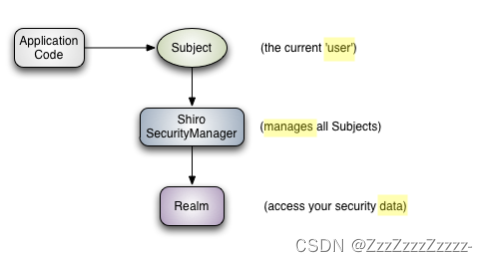
- Subject:应用代码直接交互的对象是Subject,也就是说Shiro的对外API 核心就是Subject。Subject 代表了当前“用户”,这个用户不一定是一个具体的人,与当前应用交互的任何东西都是Subject,如网络爬虫,机器人等;与Subject 的所有交互都会委托给SecurityManager;Subject 其实是一个门面,SecurityManager才是实际的执行者
- SecurityManager:安全管理器;即所有与安全有关的操作都会与SecurityManager交互;且其管理着所有Subject;可以看出它是Shiro的核心,它负责与Shiro的其他组件进行交互,它相当于SpringMVC中DispatcherServlet的角色
- Realm:Shiro从Realm 获取安全数据(如用户、角色、权限),就是说SecurityManager要验证用户身份,那么它需要从Realm 获取相应的用户进行比较以确定用户身份是否合法;也需要从Realm 得到用户相应的角色/权限进行验证用户是否能进行操作;可以把Realm 看成DataSource
15.1.4.Shiro架构(内部)

- Subject:任何可以与应用交互的“用户”;
- SecurityManager:相当于SpringMVC中的DispatcherServlet;是Shiro的心脏;所有具体的交互都通过SecurityManager进行控制;它管理着所有Subject、且负责进行认证、授权、会话及缓存的管理。
- Authenticator:负责Subject 认证,是一个扩展点,可以自定义实现;可以使用认证策略(Authentication Strategy),即什么情况下算用户认证通过了;
- Authorizer:授权器、即访问控制器,用来决定主体是否有权限进行相应的操作;即控制着用户能访问应用中的哪些功能;
- Realm:可以有1 个或多个Realm,可以认为是安全实体数据源,即用于获取安全实体的;可以是JDBC 实现,也可以是内存实现等等;由用户提供;所以一般在应用中都需要实现自己的Realm;
- SessionManager:管理Session 生命周期的组件;而Shiro并不仅仅可以用在Web 环境,也可以用在如普通的JavaSE环境
CacheManager:缓存控制器,来管理如用户、角色、权限等的缓存的;因为这些数据基本上很少改变,放到缓存中后可以提高访问的性能 - Cryptography:密码模块,Shiro提高了一些常见的加密组件用于如密码加密/解密。
15.2.Hello World
15.2.1.新建springboot-08-shiro项目

-
官方的quickstart : https://github.com/apache/shiro/tree/master/samples/quickstart/
-

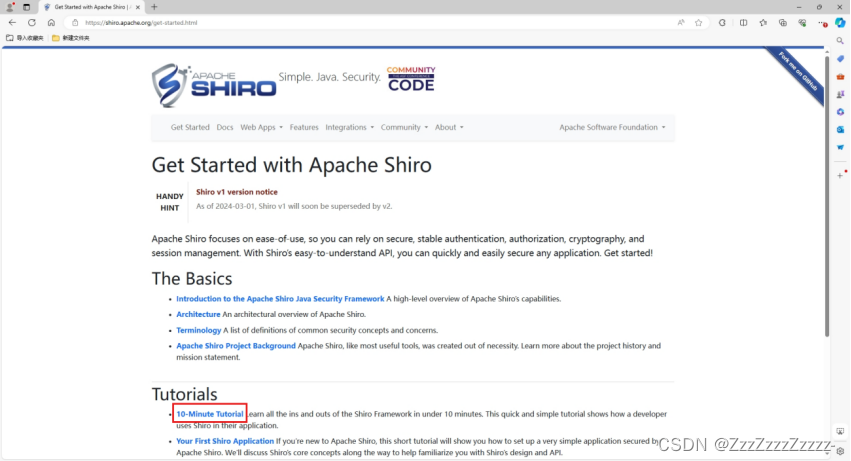
从https://github.com/apache/shiro这个页面下载整体压缩包
,使用的是D:\shiro-main\samples\quickstart
15.2.2.新建名为hello-shiro的module
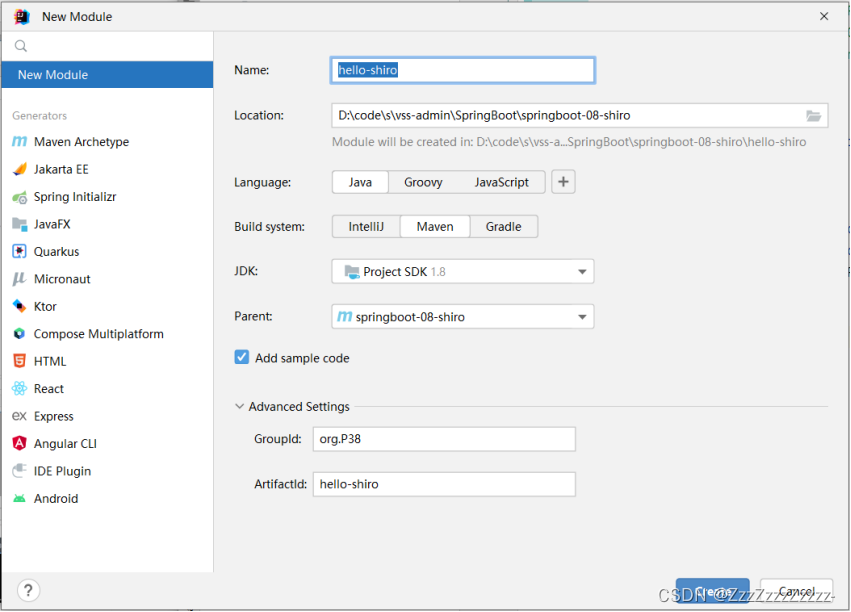
15.2.2.1.修改springboot-08-shiro\hello-shiro\pom.xml
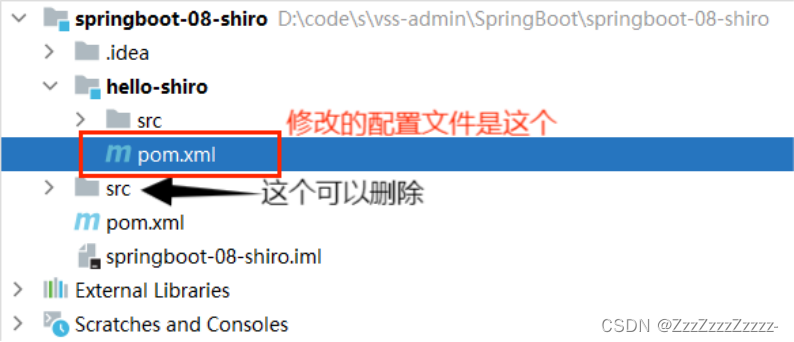
本质是对照quickstart添加相应的、带版本号的依赖(去
https://mvnrepository.com/里下载相应版本)
<?xml version="1.0" encoding="UTF-8"?>
<project xmlns="http://maven.apache.org/POM/4.0.0"
xmlns:xsi="http://www.w3.org/2001/XMLSchema-instance"
xsi:schemaLocation="http://maven.apache.org/POM/4.0.0 http://maven.apache.org/xsd/maven-4.0.0.xsd">
<parent>
<artifactId>springboot-08-shiro</artifactId>
<groupId>org.P38</groupId>
<version>1.0-SNAPSHOT</version>
</parent>
<modelVersion>4.0.0</modelVersion>
<artifactId>hello-shiro</artifactId>
<properties>
<maven.compiler.source>8</maven.compiler.source>
<maven.compiler.target>8</maven.compiler.target>
<project.build.sourceEncoding>UTF-8</project.build.sourceEncoding>
</properties>
<dependencies>
<!-- https://mvnrepository.com/artifact/org.apache.shiro/shiro-core -->
<dependency>
<groupId>org.apache.shiro</groupId>
<artifactId>shiro-core</artifactId>
<version>2.0.0</version>
</dependency>
<!-- configure logging -->
<!-- https://mvnrepository.com/artifact/org.slf4j/jcl-over-slf4j -->
<dependency>
<groupId>org.slf4j</groupId>
<artifactId>jcl-over-slf4j</artifactId>
<version>2.0.7</version>
</dependency>
<!-- https://mvnrepository.com/artifact/org.apache.logging.log4j/log4j-slf4j2-impl -->
<dependency>
<groupId>org.apache.logging.log4j</groupId>
<artifactId>log4j-slf4j2-impl</artifactId>
<version>2.20.0</version>
</dependency>
<!-- https://mvnrepository.com/artifact/org.apache.logging.log4j/log4j-core -->
<dependency>
<groupId>org.apache.logging.log4j</groupId>
<artifactId>log4j-core</artifactId>
<version>2.20.0</version>
</dependency>
<!-- <!–这个部分是按照视频多写的,目前在quickstart中没有这个–>-->
<!-- <dependency>-->
<!-- <groupId>org.slf4j</groupId>-->
<!-- <artifactId>slf4j-log4j12</artifactId>-->
<!-- <version>1.7.21</version>-->
<!-- </dependency>-->
<!-- <dependency>-->
<!-- <groupId>log4j</groupId>-->
<!-- <artifactId>log4j</artifactId>-->
<!-- <version>1.2.17</version>-->
<!-- </dependency>-->
</dependencies>
</project>
15.2.2.2.复制quickstart中的log4j2.xml,shiro.ini和Quickstart.java到本项目类似的位置
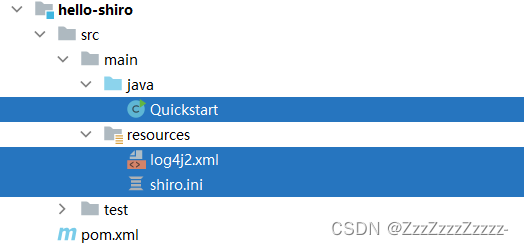
15.2.2.3.运行Quickstart.java
出现错误:类文件具有错误的版本 55.0, 应为 52.0
请删除该文件或确保该文件位于正确的类路径子目录中。
修改了使用的角度看版本也无济于事,我查看了一下官方文档,需要使用的版本应该是11+,所以这个版本行不通,返回GitHub重新下载低版本的进行学习。
15.2.3.使用1.4.x版本
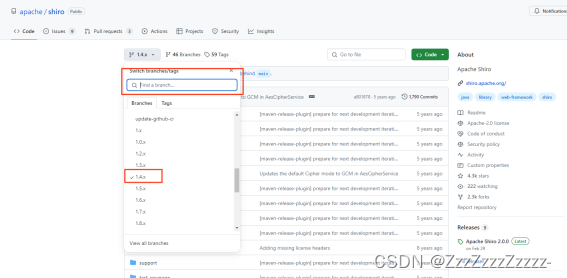
15.2.3.1.重新修改pom.xml
<?xml version="1.0" encoding="UTF-8"?>
<project xmlns="http://maven.apache.org/POM/4.0.0"
xmlns:xsi="http://www.w3.org/2001/XMLSchema-instance"
xsi:schemaLocation="http://maven.apache.org/POM/4.0.0 http://maven.apache.org/xsd/maven-4.0.0.xsd">
<parent>
<artifactId>springboot-08-shiro</artifactId>
<groupId>org.P38</groupId>
<version>1.0-SNAPSHOT</version>
</parent>
<modelVersion>4.0.0</modelVersion>
<artifactId>hello-shiro</artifactId>
<properties>
<maven.compiler.source>8</maven.compiler.source>
<maven.compiler.target>8</maven.compiler.target>
<project.build.sourceEncoding>UTF-8</project.build.sourceEncoding>
</properties>
<dependencies>
<!-- https://mvnrepository.com/artifact/org.apache.shiro/shiro-core -->
<dependency>
<groupId>org.apache.shiro</groupId>
<artifactId>shiro-core</artifactId>
<version>1.4.1</version>
</dependency>
<!-- configure logging -->
<!-- https://mvnrepository.com/artifact/org.slf4j/jcl-over-slf4j -->
<dependency>
<groupId>org.slf4j</groupId>
<artifactId>jcl-over-slf4j</artifactId>
<version>1.7.21</version>
</dependency>
<dependency>
<groupId>org.slf4j</groupId>
<artifactId>slf4j-log4j12</artifactId>
<version>1.7.21</version>
</dependency>
<dependency>
<groupId>log4j</groupId>
<artifactId>log4j</artifactId>
<version>1.2.17</version>
</dependency>
</dependencies>
</project>
15.2.3.2.重新复制quickstart中的log4j.properties,shiro.ini和Quickstart.java到本项目类似的位置

15.2.3.3.运行Quickstart.java
能够打印出日志
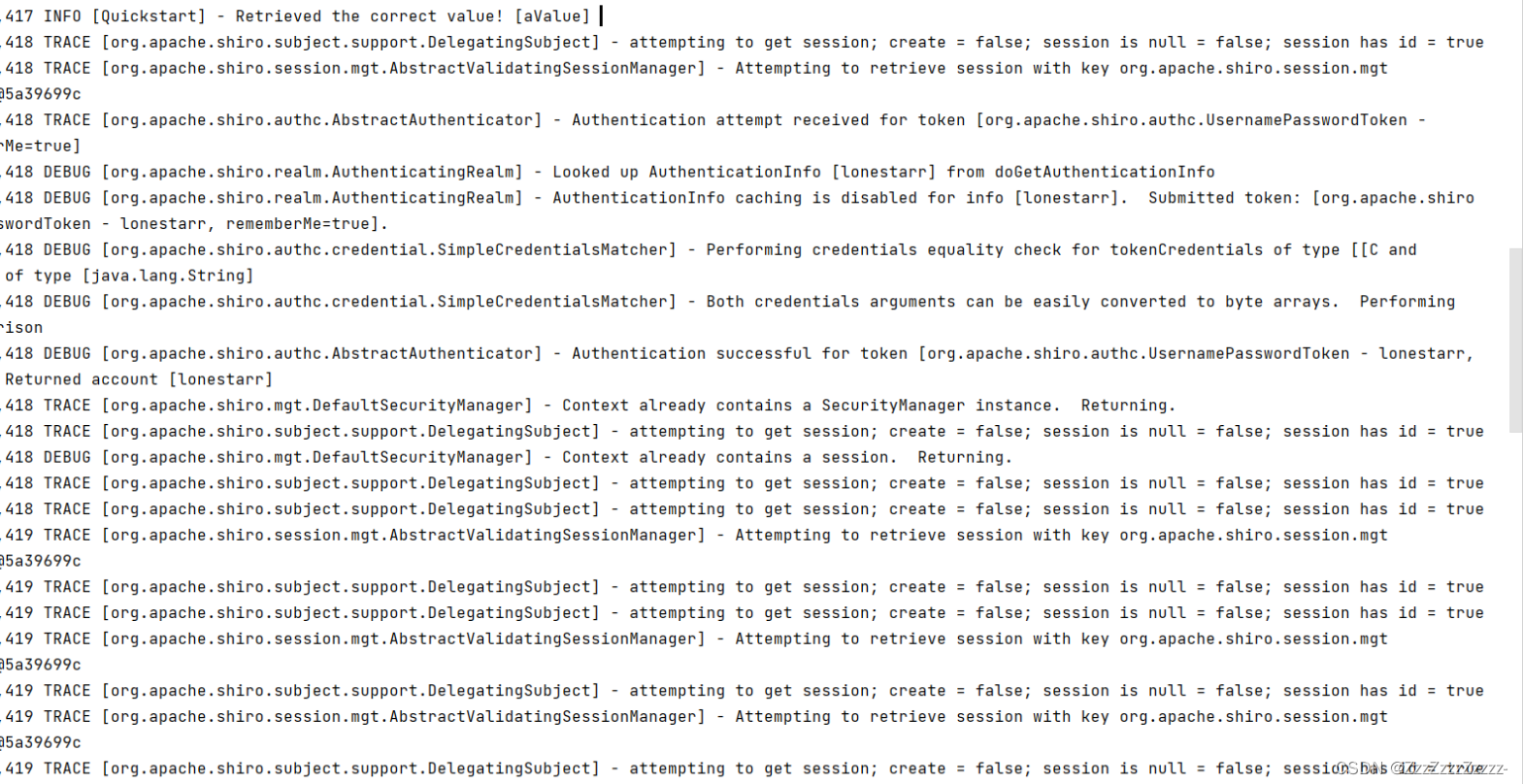
对该文件进行学习并注释
/*
* Licensed to the Apache Software Foundation (ASF) under one
* or more contributor license agreements. See the NOTICE file
* distributed with this work for additional information
* regarding copyright ownership. The ASF licenses this file
* to you under the Apache License, Version 2.0 (the
* "License"); you may not use this file except in compliance
* with the License. You may obtain a copy of the License at
*
* http://www.apache.org/licenses/LICENSE-2.0
*
* Unless required by applicable law or agreed to in writing,
* software distributed under the License is distributed on an
* "AS IS" BASIS, WITHOUT WARRANTIES OR CONDITIONS OF ANY
* KIND, either express or implied. See the License for the
* specific language governing permissions and limitations
* under the License.
*/
import org.apache.shiro.SecurityUtils;
import org.apache.shiro.authc.*;
import org.apache.shiro.config.IniSecurityManagerFactory;
import org.apache.shiro.mgt.SecurityManager;
import org.apache.shiro.session.Session;
import org.apache.shiro.subject.Subject;
import org.apache.shiro.util.Factory;
import org.slf4j.Logger;
import org.slf4j.LoggerFactory;
/**
* Simple Quickstart application showing how to use Shiro's API.
* 简单入门Shiro使用API
*
* @since 0.9 RC2
*/
public class Quickstart {
private static final transient Logger log = LoggerFactory.getLogger(Quickstart.class);
public static void main(String[] args) {
// The easiest way to create a Shiro SecurityManager with configured
// realms, users, roles and permissions权限 is to use the simple INI config.指的是配置到shiro.ini文件中
// We'll do that by using a factory that can ingest接待 a .ini file and
// return a SecurityManager instance:
// Use the shiro.ini file at the root of the classpath使用根目录下classpath的shiro.ini文件
// (file: and url: prefixes load from files and urls respectively):
// 读取配置文件:
Factory<SecurityManager> factory = new IniSecurityManagerFactory("classpath:shiro.ini");
SecurityManager securityManager = factory.getInstance();
// for this simple example quickstart, make the SecurityManager
// accessible as a JVM singleton. Most applications wouldn't do this
// and instead rely on their container configuration or web.xml for
// webapps. That is outside the scope of this simple quickstart, so
// we'll just do the bare minimum so you can continue to get a feel
// for things.
SecurityUtils.setSecurityManager(securityManager);
// Now that a simple Shiro environment is set up, let's see what you can do:
//以下是重点代码
// get the currently executing user:
// 获取当前的用户对象 Subject
Subject currentUser = SecurityUtils.getSubject();
// Do some stuff with a Session (no need for a web or EJB container!!!)
//通过当前用户拿到Shiro的Session 可以脱离web存值取值
Session session = currentUser.getSession();
session.setAttribute("someKey", "aValue");
String value = (String) session.getAttribute("someKey");
if (value.equals("aValue")) {
log.info("Retrieved the correct value! [" + value + "]");
}
// let's login the current user so we can check against roles and permissions:
//判断当前的用户是否被认证(和SpringSecurity语法相同)
if (!currentUser.isAuthenticated()) {
//Token 令牌
UsernamePasswordToken token = new UsernamePasswordToken("lonestarr", "vespa");
//设置记住我
token.setRememberMe(true);
try {
//执行登录操作
currentUser.login(token);
} catch (UnknownAccountException uae) { //用户名错误
log.info("There is no user with username of " + token.getPrincipal());
} catch (IncorrectCredentialsException ice) { //密码错误
log.info("Password for account " + token.getPrincipal() + " was incorrect!");
} catch (LockedAccountException lae) { //账户被锁定
log.info("The account for username " + token.getPrincipal() + " is locked. " +
"Please contact your administrator to unlock it.");
}
// ... catch more exceptions here (maybe custom ones specific to your application?
catch (AuthenticationException ae) { //认证异常
//unexpected condition? error?
}
// 如果没有此权限:抱歉,光剑是绝地武士专属武器
// 账号: 孤独的斯塔尔(Lone Starr) 进行登陆操作!
// 如果拥有角色:Schwartz(应该原力)
// 如果有此权限,提示:你可以使用光剑,用它秀吧!
}
//say who they are:
//print their identifying principal (in this case, a username):
log.info("User [" + currentUser.getPrincipal() + "] logged in successfully.");
//test a role:
// 检查角色
if (currentUser.hasRole("schwartz")) {
log.info("May the Schwartz be with you!");
} else {
log.info("Hello, mere mortal.");
}
//test a typed permission (not instance-level)
//粗粒度
if (currentUser.isPermitted("lightsaber:wield")) {
log.info("You may use a lightsaber ring. Use it wisely.");
} else {
log.info("Sorry, lightsaber rings are for schwartz masters only.");
}
//a (very powerful) Instance Level permission:
//细粒度
if (currentUser.isPermitted("winnebago:drive:eagle5")) {
log.info("You are permitted to 'drive' the winnebago with license plate (id) 'eagle5'. " +
"Here are the keys - have fun!");
} else {
log.info("Sorry, you aren't allowed to drive the 'eagle5' winnebago!");
}
//两种不同粒度的权限,对应shiro.ini中三种用户所拥有的不同权限进行判断
//all done - log out!
//注销
currentUser.logout();
//结束
System.exit(0);
}
}
- Spring Security中都有对应的功能(只是换了个名字)
// 获取当前的用户对象 Subject
Subject currentUser = SecurityUtils.getSubject();
Session session = currentUser.getSession();
currentUser.isAuthenticated()
currentUser.getPrincipal()
currentUser.hasRole("schwartz")
currentUser.isPermitted("lightsaber:wield")
currentUser.logout();








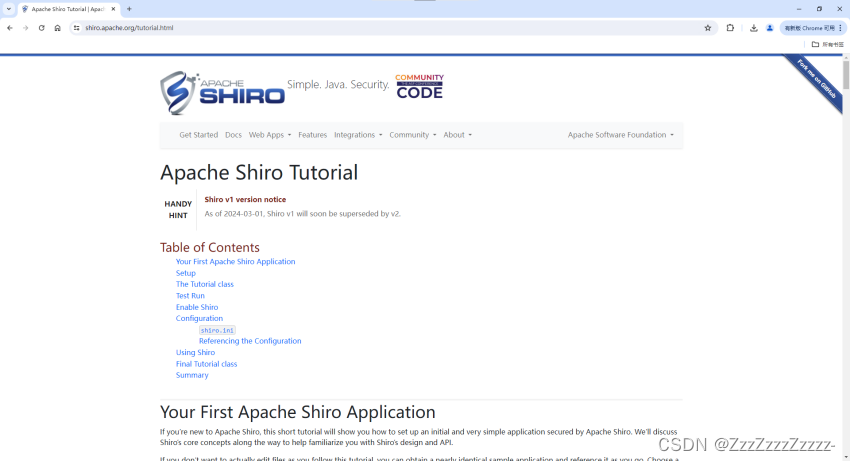














 885
885

 被折叠的 条评论
为什么被折叠?
被折叠的 条评论
为什么被折叠?








